Browning Artifacts
As well as being able to research the letters and manuscripts of the Brownings and a third of their own personal library, scholars and visitors are always surprised to find such an accumulation of the Brownings' personal artifacts in Waco, Texas.
Navigate through the categories below and gain an insight into the poets as ordinary people. View works of art that they enjoyed, pieces of their family jewelry, furniture used at the various residences, several of their household items, and memorabilia of a more personal nature. Catch a glimpse into the daily lives of the Brownings.
| Prie-Dieu French, 17th century Location: EBB Salon This prayer stand made of knotty pine and cedar, with inlaid paneling, was used at Casa Guidi and later in Pen Browning's home, Palazzo Rezzonico, in Venice. The prie-dieu was presented to the Library in 1959 by Mrs. Guy Campbell of Washington D.C., a niece of Fannie Coddington Browning. |
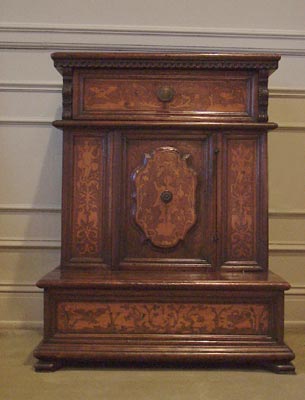 |
| Inlaid Table Persian, c. 1600s Location: Treasure Room This beautifully designed table was purchased by Robert Browning in 1889 while he was staying with his son at Palazzo Rezzonico in Venice. Styled after Middle Eastern designs, the top of the table is inlaid with mother-of-pearl, with alternating geometrical patterns of inlaid ebony and ivory around the margins. The legs and cross trestles are also inlaid with ivory. The table was obtained in 1959 from Mrs. Guy Campbell of Washington, D.C., a niece of Pen Browning 's wife, Fannie Coddington Browning. |
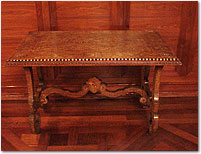 |
| Sofa Table English, c. 1810 Location: EBB Salon This drop-leaf table, with a rosewood top, is inlaid with birds-eye maple and walnut. Elizabeth and her sisters, Henrietta and Arabella, received similar tables from their grandmother, Elizabeth Moulton. It is fabled that Elizabeth Barrett Browning's famous Sonnets from the Portuguese were composed on this table during her residence at 50 Wimpole Street. The two side chairs pictured with the desk have olive-wood frames and wicker bottoms. They were used at Casa Guidi and given by Robert Browning to the Edmund Tweedy family. The chairs were given to the Library in 1968 by Mrs. Mellick Tweedy of San Angelo, Texas. |
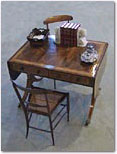 |
| Desk Chair Location: Entrance Foyer On loan from the Yale University Art Gallery
Robert Browning's wicker-bottomed, mahogany chair was a gift to Yale English professor William Lyon Phelps from his students and has been on loan to the Armstrong Browning Library from the Yale University Art Gallery since 1989. Originally owned by Browning's father, Robert Browning, Sr., the chair was paired with the poet's desk in his London study at 29 DeVere Gardens when he returned from Italy in 1861 after his wife's death. |
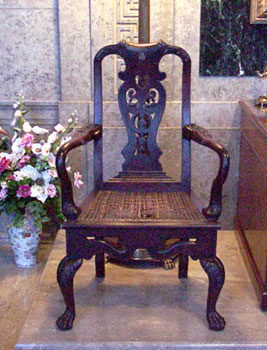 |
| Partner's Pedestal Writing Desk Location: Entrance Foyer It is believed that Robert Browning wrote some of his greatest poetry at this desk at both his Warwick Crescent and DeVere Gardens homes. It is the central feature in Felix Moscheles' watercolor entitled Robert Browning's Study. The double-sided desk is mahogany with a black inlaid leather top. It was presented to the Library in 1949 by the Raleigh Hotel of Waco, Texas, and Mrs. C. H. Alberding of Chicago, Illinois. |
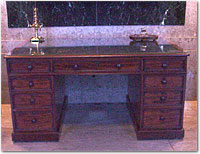 |
| Mahogany Folding Chair Location: Treasure Room This mahogany and green velvet folding chair with hand-carved arms and legs belonged to the Brownings during their residence at Casa Guidi. Originally upholstered in red, it can be seen in George Mignaty's 1861 painting of their Florentine drawing room, which is displayed in the Austin Moore-Elizabeth Barrett Browning Salon on the third floor of the Library. The chair was a gift to the Library in April 1951 from the Lakeside Browning Club of Dallas, Texas. |
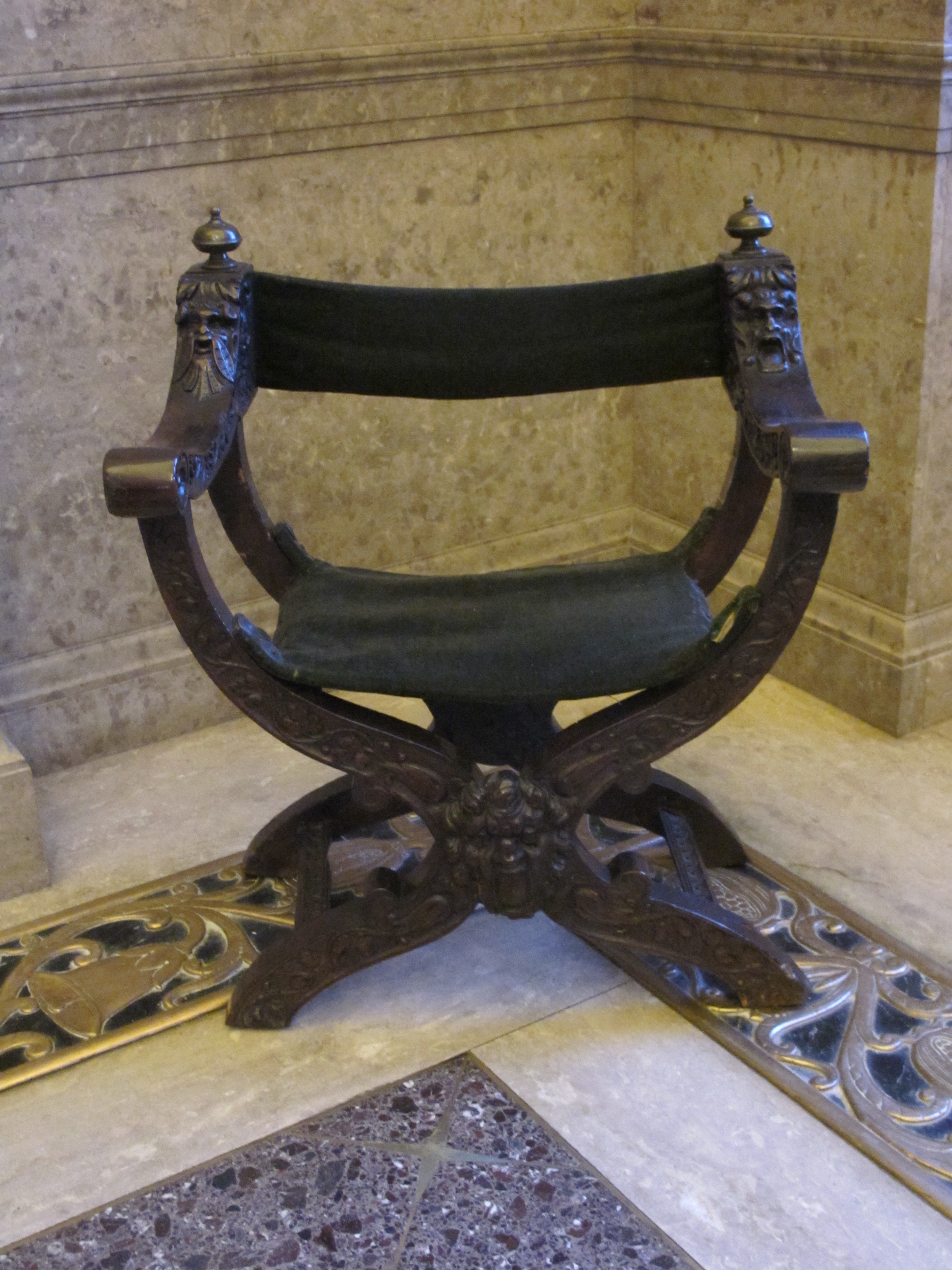 |
| Escritoire Italian, c. 1650 Location: Treasure Room This writing desk, which the Brownings bought in Florence during their honeymoon, has a folding top and a pull-down front with an elaborate, hand-carved floral design ornamenting the desk's exterior. It is fitted with 12 drawers and was a convenient height for the poet to stand and write. It was purchased from the Browning estate at the 1913 Sotheby Sale by Mrs. Florence Barclay, who left it to her daughter, Mrs. Angela Whitcombe. Mrs. Whitcombe stored the desk with a friend, who mistakenly sold it to Andrew Burden, who then offered it for sale to the Library. The entire purchase price, including shipping charges was $644.14. Funds for the purchase were provided by the Lambda Alpha Chapter of Baylor's honorary English society, Sigma Tau Delta. |
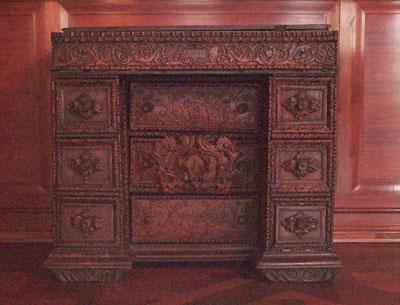 |
| Bracket Clock Crafted by Bates, of Huddersfield, c. 1814 Location: Treasure Room Made of rosewood on a brass-mounted base, this clock was owned by three generations of Brownings, beginning with Robert Browning's father. When wound it will run and chime, but it no longer keeps accurate time. The clock was a gift to the Armstrong Browning Library in 1949 from the Women's Auxiliary of the Waco Press Club. |
 |
| Candlesticks Location: Research Hall The Brownings used this matching pair of silver candlesticks, 8 1/2 in. high, with Roman motif bases of 4 3/4 in. diameter, at their Bagni di Lucca residence. In 1930, Dr. A.J. Armstrong was instrumental in having a plaque affixed to the house. After the celebration, Dr. Bastiani, owner of the home, presented the candlesticks to Dr. Armstrong. |
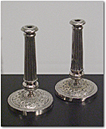 |
| Cream Pitcher Location: Research Hall This porcelain cream pitcher, white with blue edging, 4 3/4 in. high, was used by Elizabeth Barrett Browning at Casa Guidi. It was added in 1948 through the Sir Wilfred Meynell Collection, along with EBB's lace mittens, mantilla, and folding fan (pictured in the Relics & Other Objects section). |
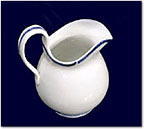 |
| Oil Lamp & Taper Stand Location: Research Hall The bronze taper stand, 8 in. high with a 6 in. flared base, belonged to Robert Browning. Reportedly, the Brownings also used the silver-plated oil lamp; 4 in. high x 3 3/4 in. diameter. |
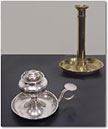 |
| Stuffing Spoons Crafted by Henry Wilkinson & Co., 1836 Location: Research Hall These silver stuffing spoons, 14 in. long with bowl 2 in. wide, are adorned with beaded edges and engraved with the Browning crest. They were personal possessions of the Brownings and given by Florence Weir Gibson in 1945. |
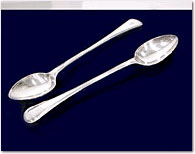 |
|
Silver Cream Pitcher Silver Teaspoons The cream pitcher and the four spoons are all engraved with the initials R.J.B., which stand for Robert and Jane Browning. The poet's grandfather, also named Robert Browning, was first married to Margaret Tittle, who was the poet's grandmother. The teaspoons were part of a set of six given as a wedding present in 1809 to the poet's parents, Robert and Sarah Wiedeman Browning. |
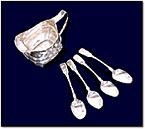 |
| Signet Finger Ring Location: Research Hall A band of 22-carat gold, set with a green bloodstone which measures 5/16 in. x 7/16 in. and bearing an intaglio of the Browning crest and motto, was worn by Robert Browning for about 40 years. It is visible in a number of his portraits and photographs and the impression of the rampant lion crest is evident on a number of envelopes in the Armstrong Browning Library manuscript collection. |
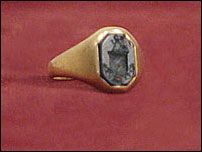 |
| "Friendship" Seal Ring Location: Research Hall The chalcedony gemstone, in a gold setting, bears a clasped-hands design and the word L'AMITE appearing backwards so the ring can be used for making impressions on wax. The ring was not designed for finger wear but has attachments for wearing on a chain. It originally belonged to an uncle of Elizabeth Barrett Browning's, then to her, and then to Pen, who gave it to Fannie Coddington as an "engagement ring." Brooch The 2 1/2 in. long gold brooch, with intricate floral design and three amber topazes, was given by Robert to Elizabeth on their first wedding anniversary, and later given by him to Fannie Browning. It was presented by Fannie to Mrs. Herbert Stead. Cross Necklace The black onyx cross, decorated with diamond chips, silver, and a central pearl, is attached to a 17-inch chain composed of black onyx rods and cylinders. It was given by Robert to Elizabeth on their honeymoon in 1846. It was later given by Browning to his daughter-in-law, Fannie. |
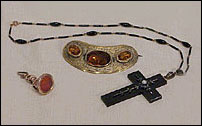 |
| Ring Location: Treasure Room
Gold with 2 rows of diamonds, this ring belonged to Browning's mother, Sarah. Brooch Enclosed in a gold memorial brooch is a lock of hair of the poet's grandfather (also named Robert Browning). It is surrounded with 26 seed pearls and inscribed: "Obt. Decr. 11th 1833-At.84." |
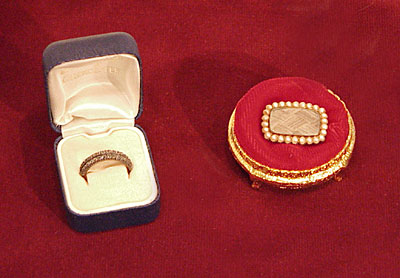 |
| Links Location: Research Hall
This pair of gold links belonged to Elizabeth Barrett Browning's cousin George Goodin Barrett (1792 - 1854). The set passed into the possession of George Goodin Moulton-Barrett (1864 - 1943), Elizabeth Barrett Browning's nephew, from whose estate they were acquired. Brooch The gold mounted topaz brooch, fashioned from Elizabeth Barrett Browning's father's seal with his initials (EBMB) in reverse and the Barrett griffin, once belonged to EBB. It was later presented by Pen Browning to Mrs. George Murray Smith. |
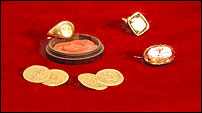 |
| Victorian Traveling Tea Set Location: Treasure Room Jean Sherwood, an American art critic, shared tea unknowingly with Robert Browning on a train in Italy in 1889. This wicker basket and its accompanying tea set were used on that occasion. Later, Mrs. Sherwood came to Waco for Dr. A. J. Armstrong's lyceum in 1936 and presented the tea basket to the Browning Collection. Basket is 9 1/4 in. x 5 3/4 in. x 5 1/2 in.; set includes a teapot and burner, tea tin, two enameled pewter cups and saucers, and a small unadorned silver spoon. |
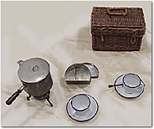 |
| Dresden Inkstand, Lead Pencil, & Lock of Hair Location: Research Hall Inkstand Pencil Locket |
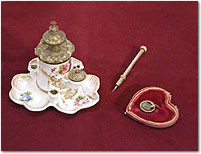 |
| Elizabeth's Lace Pieces Location: Treasure Room Mittens Mantilla Edging |
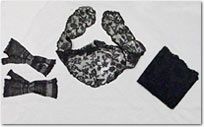 |
| Robert Browning's Oil Lamp Location: Entrance Foyer Oil Lamp |
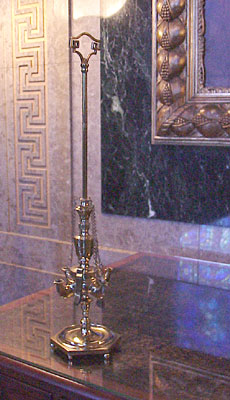 |
| Robert Browning's Inkwell Location: Entrance Foyer Inkwell |
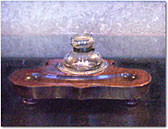 |
| Elizabeth Barrett Browning's Fan Location: EBB Salon Folding fan, dark green muslin with gold border, on 15 wooden braces, 15 in. x 8 in. when opened; inscribed in unidentified hand: "E.B.B. 1859. Rome." It is visible lying on a chair in George Mignaty's painting, Salon at Casa Guidi, which was commissioned by Browning shortly after his wife's death in 1861. The fan was acquired through the Sir Wilfred Meynell Collection in 1948, along with EBB's lace mittens and mantilla and a small cream pitcher. |
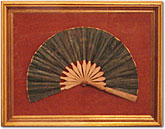 |
| Laurel Leaves from Robert Browning's Funeral Location: Research Hall Gift of Lady Teresa Berwick, Attingham Park, Shrewsbury, England, who found the leaves among the papers of her mother, Mrs. Zina Hulton. She had received them from Mrs. Katharine deKay Bronson, a close friend of Browning from 1880 to 1889. The leaves, which Mrs. Bronson had saved from the wreath on RB's casket, range in length from 4 1/2 to 5 1/2 in. and are preserved in a glassed wooden frame which measures 5 in. x 11 1/2 in. |
 |
| Letter Box Location: Research Hall A small wooden letter box, covered with an embroidered fabric and lined inside with green silk, 9 1/4 in. x 6 in. x 2 in. Robert Browning's initials are embroidered a total of 24 times on the top and sides; it is believed to have been used as a letter box at Casa Guidi. |
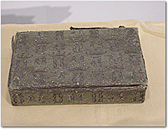 |
| Letter Tray Location: EBB Salon This mahogany letter tray on Chippendale bracket feet, with flared sides, belonged to Elizabeth Barrett Browning. Overall, the piece, decorated with carved pierced hand holds, stands 9 1/2 in. x 7 1/2 in. x 4 1/2 in. The upper tray is 7 1/2 in. x 5 1/2 in. x 2 in. In the lower portion, an integral drawer, with brass pull, measures 7 1/2 in. x 5 in. x 1 in. |
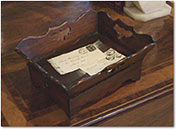 |
| Victorian Picture Case Location: Research Hall Pine frame, covered with leather, velvet, and dark brown paper; 5 3/8 in. x 7 1/8 in. x 3/4 in.; holds a small print of the Fox-Bridell portrait of Elizabeth Barrett Browning (1858). It was in Elizabeth's possession at Casa Guidi and was a gift from her to Pen. He presented it to Ersilia Nardini, a member of his household staff. The case was given to the Library in 1968 by Ruth Borchardt, Curator of Casa Guidi. |
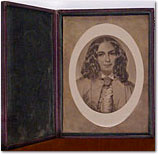 |
| A Single Rose Sent in Robert's Love Letter to Elizabeth Location: Treasure Room A single rose, grown in Browning's mother's garden at Hatcham, South London, was sent in a love letter from Robert Browning to Elizabeth Barrett: ...this hot day draws out our very first yellow rose. 14 June 1845. |
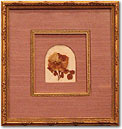 |
| Robert Browning's Snuff Box Location: Research Hall A Georgian silver, crescent-shaped, engine-turned snuff box made by John Lawrence & Co. of Birmingham in 1797, with "R.B." engraved on the lid, measures 2 1/2 in. x 1 3/4 in. x 3/4 in. It was reputedly given by Browning's daughter-in-law, Fannie Coddington Browning, to John Ruskin and was still in his possession at his death in 1900. |
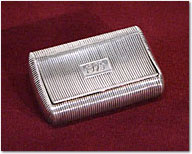 |
| Doorknocker Location: Treasure Room A fifteenth-century doorknocker, in the form of a large wrought-iron ring and spike, was used at Palazzo Dario, Venice, where Pen Browning resided briefly before moving to Palazzo Rezzonico. The ring is 3 7/8 in. x 3 3/4 in., with a spike 4 1/2 in. long. |
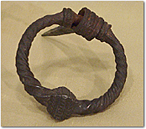 |
| Edelweiss Blossoms Location: Treasure Room Four blossoms, under glass, in a decorated wooden box which measures 4 in. x 2 3/4 in. x 1 3/8 in. A note by A.J. Armstrong inside the lid, undated and unsigned, reads-- Edelweiss picked by Robert Browning at St. Moritz Switzerland in 1884, and sent by him to Mrs. Katharine deKay Bronson. Given to Dr. A. J. Armstrong in 1927 by her daughter Princess Editha Rucellai in Florence. |
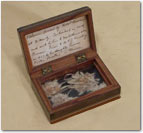 |
| Hope End, Watercolor Artist: Unknown Dimensions: 11 1/2" x 15 1/2" Location: Director's Office
Hope End, signifying "a closed valley," was Elizabeth Barrett's childhood home near Ledbury, Herefordshire, England. Her bedroom and sitting room were at the very top of the house. This is a view from the lower pond. |
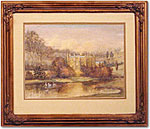 |
| Robert Wiedeman Barrett (Pen) Browning, Pen and Chalk Artist: Samuel Laurence, c. 1853 Dimensions: 13" x 10" Location: EBB Salon
The artist also created a companion portrait of Elizabeth Barrett Browning during the same time period. |
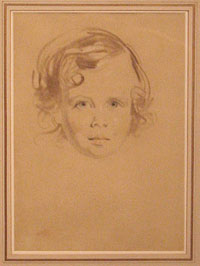 |
| Robert Wiedeman Barrett (Pen) Browning, Oil Artist: Euphrasia Fanny Haworth, c. 1857 Dimensions: 11" x 8" Location: EBB Salon
This painting is described by Elizabeth Barrett Browning in a letter to her sister Arabella on January 10, [1857]. Although Pen was eight years old, his mother still enjoyed his curls and dressed him in velvet and lace. Gift of Irving Bush, Jr. |
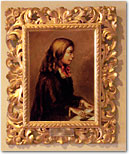 |
| Pen Browning, White Carrera Marble Artist: Alexander Munro, 1859 Location: Entrance Foyer
Commissioned by Robert Browning for his wife Elizabeth, the bust of their son, Robert Wiedeman Barrett Browning, was modeled in 1858 for a fee of 25 guineas which was a considerable sum of money at the time. Although Pen was almost ten years old, he was still dressed in a fashion more suitable for a Victorian boy of four or five. Elizabeth wanted him raised in an androgynous manner, hence the bust's long curls and feminine mode of dress. Robert did not agree with this idea. Following Elizabeth's death in 1861, Browning had Pen's hair cut and dressed him in a young man's clothing. The bust was a gift in 1922 from the Highland Park Browning Society, Dallas, Texas. |
 |
| John Kenyon, White Carrera Marble Artist: Thomas Crawford, 1841 Location: Entrance Foyer
This life-sized bust was done in 1841, when John Kenyon was 57 years old; it eventually belonged to the Brownings. A distant cousin of Elizabeth Barrett and a close friend of Robert Browning, Kenyon was responsible for the two poets' meeting. Elizabeth Barrett had mentioned Browning very favorably in her poem "Lady Geraldine's Courtship." Kenyon gave a copy to Robert and encouraged him to thank her--this began a correspondence that led to their courtship and marriage. Kenyon was very close to the couple, helping them financially during his lifetime and leaving them a generous sum of money in his will. The bust was given to the Browning Collection in 1944 by the Neiman-Marcus Company of Dallas, Texas. |
 |
| Sarianna Browning, Oil Artist: Possibly Euphrasia Fanny Haworth Dimensions: Location: Research Hall
Sarianna Browning, the poet's sister and younger sibling (1814 - 1903), never married but devoted her entire life to her father, her brother, and her nephew. |
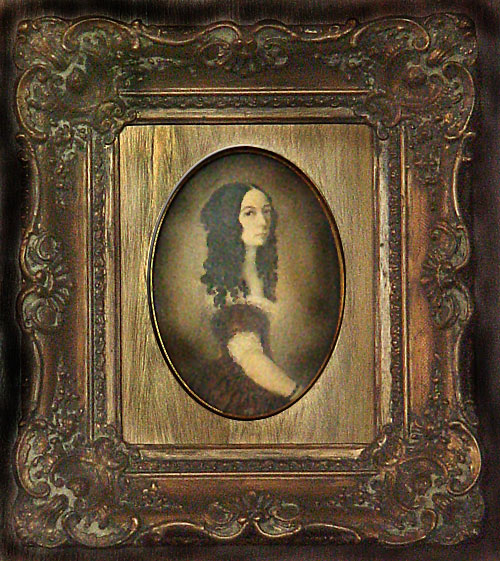 |
| Possibly Saint Sebastian, Oil Artist: Italian School, c. 1500 Dimensions: 6' x 2' 3" Location: Research Hall
This painting hung in the Brownings' home in Florence. From the Italian school of the Correggio Period, Saint Sebastian is the patron saint of good health. |
 |
|
The Madonna, Oil Although neither the artist nor the exact date of this painting are known, the style is identified as being that of the Italian School. The Madonna originally belonged to the Brownings and hung in the salon in Casa Guidi. The painting was a gift from the Lambda Alpha Chapter of Sigma Tau Delta in 1953 in honor of their sponsor, Dr. A. J. Armstrong. |
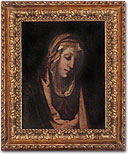 |
|
Two Saints, Oil on wood This is technically two small paintings on one wood panel. It belonged to the Brownings and hung in their home, Casa Guidi. A barely legible note by Elizabeth Barrett Browning on the reverse confirms that the artist was from the Sienese School. |
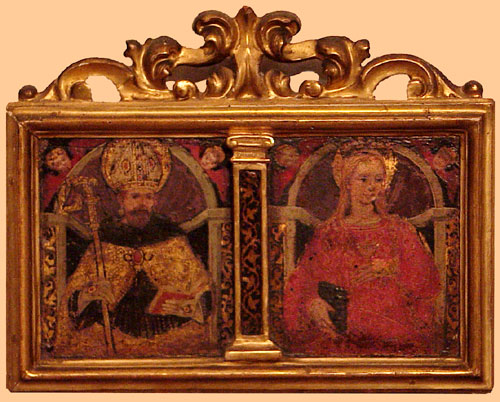 |
|
Two Children, Our Saviour and Saint John, with a Lamb, Watercolor This miniature belonged to the Brownings and is inscribed "Murillo" on the reverse by Sarianna Browning, sister of the poet. |
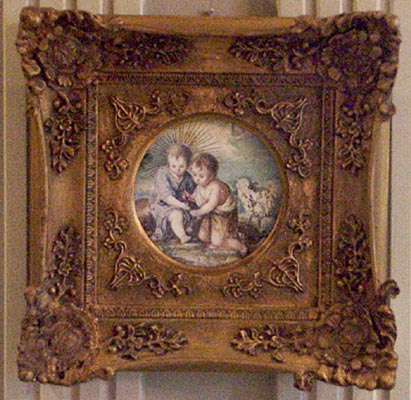 |
| Aeschylus, Bronze Bas-relief Artist: Unknown Dimensions: 16" diameter Location: Treasure Room
The plaque is a bas-relief in profile of the head of Aeschylus, the Greek playwright. It originally hung in the Brownings' drawing room at Casa Guidi in Florence. The piece was acquired by the Armstrong Browning Library from Mr. and Mrs. William Sloan in 1958. |
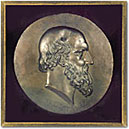 |
| The Serenade, Oil Artist: Daniel Maclise, 1842 Dimensions: 52 3/4" x 37 1/4" Location: Treasure Room
The painting depicts two male figures serenading a pair of young ladies on a canopied balcony, apparently in Venice. On Maclise's behalf, John Forster described the painting to Browning and asked him to write a few lines. This served as the inspiration for the first few lines of Robert Browning's poem, "In a Gondola." I send my heart up to thee, all my heartIn this my singing. For the stars help me, and the sea bears part; The very night is clinging Closer to Venice' streets to leave one space Above me, whence thy face May light my joyous heart to thee its dwelling place. Upon seeing the painting, Browning was stimulated to add 226 more lines to the original few. The later lines tell a tale and present a situation entirely fabricated by Browning. The painting was acquired for the Library in 1950 from H. I. Jarman. |
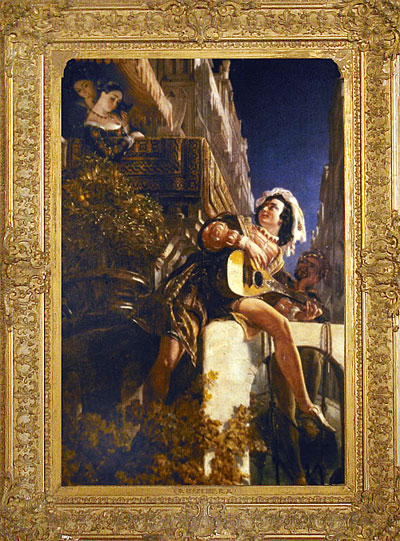 |